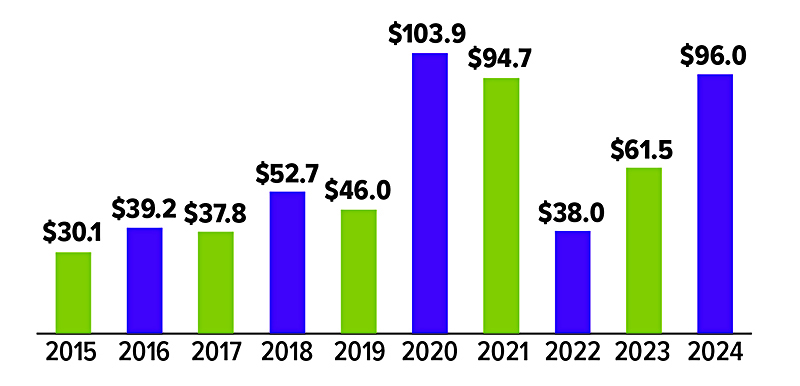A convertible bond is a regular corporate bond that comes with a special added feature: the investor has the right to convert it into shares of that company’s common stock.
U.S. convertible bond issuance reached $96.0 billion in 2024, far surpassing the $61.5 billion issued in 2023.1 The strong upward trend that began in 2023 picked up steam in 2024, driven by the resilience of the U.S. economy and interest rates that remained elevated longer than expected.2
Why companies choose convertibles
Convertible bonds tend to offer lower interest rates than ordinary bonds issued by the same company. They also provide a way for companies to raise capital while avoiding the immediate dilution of share values that occurs when new stock is sold.
Convertible bonds have long been utilized by corporations with less than stellar credit ratings, including younger companies and those with weak balance sheets. But with interest rates sitting at high levels, more established, investment-grade companies have also been relying on convertible debt to help lower their borrowing costs.
In addition, a “maturity wall” of more than $1.2 trillion in investment-grade corporate debt is coming due in the next couple of years. Many of these companies could try to save money by refinancing their debt with convertible bonds.3

What’s under the hood for investors
Bond holders will receive income and principal unless the bond issuer defaults. Convertible bonds combine the income and relative price stability of bonds with the opportunity to participate in stock market returns. Thus, their value on the open market is affected not only by interest rates, as all bonds are, but also by changes in the company’s stock price.
The bond agreement spells out either how many shares of stock the bond can be converted into (the conversion ratio), or the stock price at which the conversion can be made (the conversion price). For example, a bond that can be converted into 45 shares of stock would have a conversion ratio of 45:1. A $1,000 bond that has a conversion price of $50 a share would convert to 20 shares of stock.
If the stock’s price rises, the convertible’s price also rises, though convertibles usually are not as volatile as the stock itself. If the stock’s price falls, the convertible’s value on the open market could be less than its face value if sold before it matures, though the fixed interest it pays could help cushion the impact.
Challenges to consider
Most convertibles are callable, usually within five years after they’re issued. If the stock price doesn’t rise before the bond is called, the advantage of being able to convert the bond disappears.
Convertibles can also be relatively illiquid. As a result, individual investors may have difficulty finding buyers and sellers for small lots and end up paying higher prices than institutional investors.
In fact, liquidity is one of several reasons an investor might prefer to access convertibles through a mutual fund or exchange-traded fund (ETF) instead of purchasing individual bonds: the use of funds makes it easier to compare investment performance, and it can also help increase portfolio diversification.
Diversification is a method used to help manage investment risk; it does not guarantee a profit or protect against investment loss. The return and principal value of bonds, stocks, mutual funds, and ETFs fluctuate with changes in market conditions. Shares, when sold, may be worth more or less than their original cost. Bond funds are subject to the same inflation, interest-rate, and credit risks associated with their underlying bonds. Supply and demand may cause ETF shares to trade at a premium or discount relative to the value of the underlying shares. Investments seeking to achieve higher yields also involve a higher degree of risk.
Mutual funds are sold by prospectus. Please consider the investment objectives, risks, charges, and expenses carefully before investing. The prospectus, which contains this and other information about the investment company, can be obtained from your financial professional. Be sure to read the prospectus carefully before deciding whether to invest.

